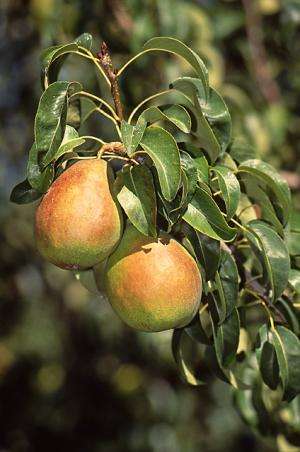Studies explore storage ideas for Anjou pears

Fresh Anjou pears, harvested in late summer from orchards in Oregon and Washington, will usually be available in supermarket produce departments through early spring of the following year. That's thanks to, in part, science-based, long-term-storage technologies that help postpone ripening.
In ongoing studies, U.S. Department of Agriculture (USDA) researcher James P. Mattheis and his colleagues are tackling some of the problems that may affect this popular pear while or after it has been kept in refrigerated, low-oxygen storage, also referred to as controlled-atmosphere storage.
Some of this research suggests that tactics that work well for keeping fresh apples free of plant diseases or other disorders while in controlled-atmosphere storage may not necessarily be quickly or easily applied to meet Anjou pears' storage needs.
In one early study, Mattheis and coinvestigator David R. Rudell, Jr., both with the USDA Agricultural Research Service (ARS) Tree Fruit Research Laboratory at Wenatchee, Wash., and former postdoctoral research associate David Felicetti, tested chlorophyll fluorescence monitoring as a candidate "early warning system" for keeping an eye on the quality of stored pears.
According to Mattheis, the technology is used successfully to detect problems in stored apples. That's because an increase in the fluorescence levels in the chlorophyll in a stored apple's peel apparently correlates well with an increase in problems linked to low oxygen levels.
When apple chlorophyll levels go up during storage, storehouse managers know to raise the oxygen level slightly to prevent damage to the fruit.
But the Anjou research, documented in scientific articles in Postharvest Biology and Technology in 2011 and 2013, showed that the monitoring system didn't work well in detecting either black speck or pithy brown core in Anjou pears that were stored, experimentally, in extremely low oxygen conditions.
The scientists found that black speck and pithy brown core occurred despite the fact that there were no detectable changes in the affected pears' chlorophyll fluorescence levels. For that reason, Mattheis is—for now—advising packers to use caution before relying on chlorophyll fluorescence for monitoring stored Anjou pears in very low oxygen conditions.
Black speck is an unwanted speckling of the pear's skin; pithy brown core, as its name implies, discolors the pear near its core and changes the pear's texture from delectable to unpleasantly fibrous.
This and related ARS-led Anjou pear research at Wenatchee is described in the January 2014 issue of Agricultural Research magazine. ARS is the USDA's chief intramural scientific research agency.
Journal information: Agricultural Research
Provided by Agricultural Research Service

















